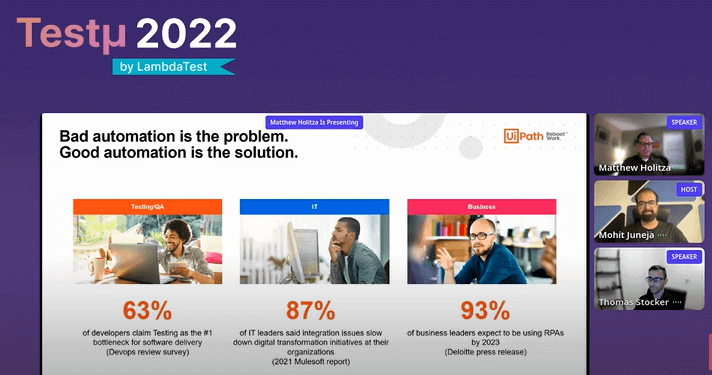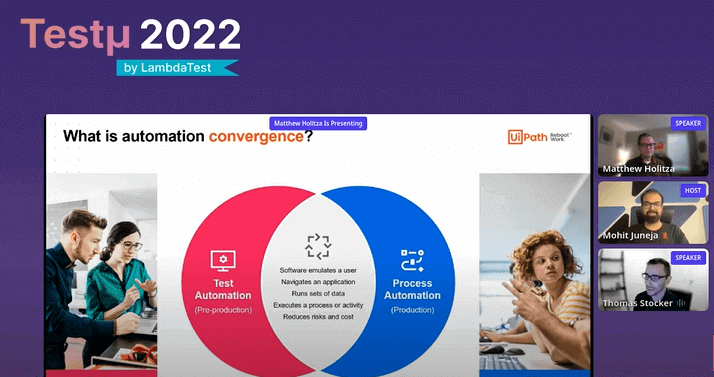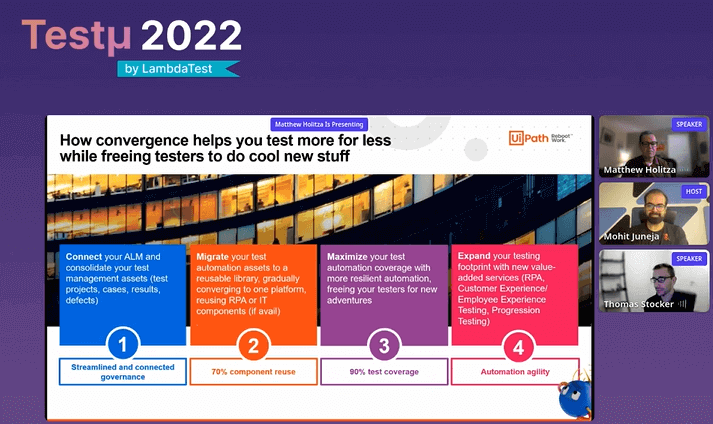Convergence Of Test Automation: Thomas Stocker & Matthew Holitza [Testμ 2022]
LambdaTest
Posted On: August 30, 2022
![]() 8124 Views
8124 Views
![]() 6 Min Read
6 Min Read
Quality assurance has been perceived as a cost center and often infamously titled as the biggest bottleneck for digital transformation. With automation testing being an enterprise-wide phenomenon and the number one priority for technology leaders, there is a potential for testing to get the C-level of attention it deserves. This, in turn, will help actively boost organizations’ ROI.
In this insightful session of the Testµ conference, Mohit Juneja – VP, Strategic Partnerships and Business Development at LambdaTest, joined hands with two industry veterans Thomas Stocker – Principal Product Manager at UiPath, and Matt Holitza – Senior Product Marketing Manager at UiPath.
Together they discussed how test engineers can spearhead the enterprise automation journey and use their automation skill set in other digital transformation areas and how sharing and reusing automation assets and infrastructure can save cost and drive ROI from overall digital transformation initiatives.
The session took off with a brief history of UiPath, where Matthew Holitza talks about how UiPath evolved from a screen screening company to a global robotic process automation platform.
Let’s look at the major highlights of this session!
Bad automation is the problem – Good automation is the solution
According to Matthew, there’s a lot of improvement in the software testing space, and automation will be an essential aspect across the enterprise. As mentioned in the introduction, testing is perceived as a bottleneck and a cost center, and there are tons of factors responsible for it. However, bad automation is the root cause.

Matthew further describes how he was striving to get 80 test automation rates for regression testing. Even twenty years later, people are still seeking that. For example, the IT sector employs automation, yet IT leaders are experiencing issues with connecting systems, etc.
So what we found is that business has become somewhat dependent on robotic process automation (RPA). Many folks consider RPA a fad; however, it is not since robotic-automation users are getting accurate results after implementing it. With all these divergent trends, we see a kind of common thread across this where bad automation is the problem and good automation is the solution, and it’s not even just good automation because it means a lot of things; like you have to do automation in the right and coordinated way.
What’s wrong with the apples and oranges approach?
Until now, we focussed on the macro problems of automation. Matthew and Thomas then went ahead and talked about what’s wrong with the apples and oranges approach. Below are the following pointers that were discussed.
- Silos of tools and shadow automation.
- The high total cost of ownership.
- No ability to reuse components or skill sets.
- Lack of automation governance.

Automation convergence and its benefits
Matthew and Thomas explored the importance of automation convergence and its benefits like synergy, speed, and opportunity.

- Synergy: If you are on the development side, you’re creating test automation, and you will reuse those automation assets to automate stuff on the IT side, to test patches that you want to deliver that go from the IT side to the business side and then when automating your business process and RPA side.
So it’s not only saving the costs, but it’s that synergy and that reliability you get because it went through so many stages, it is proven to work, and you’re good to go on the business side. - Speed: For time purposes, speed is the crucial factor. We live in times of digital transformation, and it’s important to speed up processes to leverage synergies, and that’s the perfect opportunity. If you build something once and reuse it more often, you save a lot of money. Just think about testing and test automation itself.
The significant rule is if you test something once, you probably might not create an automation for it. It doesn’t make any sense. You’re quicker doing the manual test on it, but if you’re creating a reusable automation asset that is not only used for testing but for any automation purpose throughout the company and life cycle, then it makes sense, and you will speed up the process essentially and help save cost. - Opportunity: Once you have scaled your automation across the enterprise, it allows your organization to sense and respond to new opportunities. So if a competitor comes out with something and you need to swarm a team together of automation developers now, you can do that.
Today you’re in silos, and you would have to learn the new technology on that project and apply it. It would take three or four times as long to react to some situation like that.
The outcome of automation convergence
Thomas explains what automation convergence would look like. There is a lot of automation going on in testing, development, and business. There are a lot of test automation pipelines on the testing and development side to automate a process to get your software delivered, and the same holds for the IT side.
You have automation to prepare test environments to test patches that might be delivered and, at some point, move those patches onto the business side, and on the business side, you have RPA. So there is a lot of redundancy right now.
How does convergence help you test more for less?
Thomas shed light on how UiPath can help users test more for less by integrating into their existing platforms. He discussed the following features offered by UiPath –
- Streamline and connected governance: Connect your ALM and consolidate your test management assets.
- 70% component reuse: Migrate your automation assets to a reusable library.
- 90% test coverage: Achieve greater test coverage with resilient automation.
- Automation agility: Expand your testing footprints with new value-added services like RPA, customer experience, employee experience testing, etc.

So, in a nutshell, – optimization and testing can help us achieve more significant ROI and avoid costly setbacks.
The session ended with a question asked by one of the attendees to Thomas and Matthew:
- How to convert testing from a cost to a value contributor?
After the successfull Testμ Conference 2022, where thousands of testers, QA professionals, and developers worldwide joined together to discuss on future of testing.
Join the testing revolution at LambdaTest Testμ Conference 2023. Register now!” – The testing revolution is happening, and you don’t want to be left behind. Join us at LambdaTest Testμ Conference 2023 and learn how to stay ahead of the curve. Register now and be a part of the revolution.
Got Questions? Drop them on LambdaTest Community. Visit now















